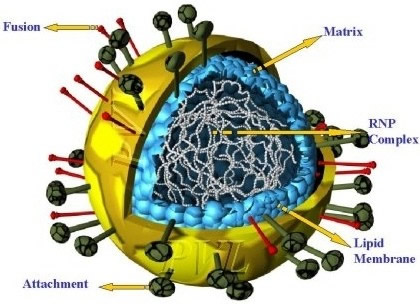Newcastle Disease is a highly
contagious viral disease affecting poultry of all ages. Affected species
include chickens, turkeys, pigeons and ducks. The condition is rarely diagnosed
in ducks but is a possible cause of production drops and fertility problems. Other
species can be infected including mammals occasionally (e.g. conjunctivitis in
man). First
found in Newcastle upon Tyne, United Kingdom in 1926.
 The virus involved is
Paramyxovirus PMV-1, which is of variable pathogenicity. Signs are typically of
disease of the nervous, respiratory or reproductive systems. Morbidity is
usually high and mortality varies 0-100%. Higher mortality is seen in velogenic
disease in unvaccinated stock.
The virus involved is
Paramyxovirus PMV-1, which is of variable pathogenicity. Signs are typically of
disease of the nervous, respiratory or reproductive systems. Morbidity is
usually high and mortality varies 0-100%. Higher mortality is seen in velogenic
disease in unvaccinated stock.
Four manifestations have been
identified:
• ND - Velogenic Viscerotropic (VVND) - sometimes called
'asiatic'
or exotic. It is highly virulent for chickens, less for turkeys.
• ND - Neurotropic Velogenic - Acute and fatal in chickens of
any
age causing neurological and some respiratory signs. Intestinal
lesions are
absent.
• ND - Mesogenic - Mortality and nervous signs in adult.
• ND - Lentogenic - Mild disease, sometimes subclinical. Can
affect
any age. Strains can be developed as vaccines.
 Transmission is via aerosols,
birds, fomites, visitors and imported psittacines. Chicks may become infected
in hatcheries from contaminated shells.
Transmission is via aerosols,
birds, fomites, visitors and imported psittacines. Chicks may become infected
in hatcheries from contaminated shells.
The virus survives for long
periods at ambient temperature, especially in faeces and can persist in houses for
up to 12 months. However it is quite sensitive to disinfectants, fumigants and
sunlight. It is inactivated by temperatures of 56°C for 3 hours or 60°C for 30
min, acid pH, formalin and phenol, and is ether sensitive.
Signs
Signs are highly variable and
will depend on the nature of the infecting virus, the infective dose and the
degree of immunity from previous exposure or vaccination.
• Sudden Death
• Inappetance.
• Coughing.
• Dyspnoea.
Severe haemorrhagic and
necrotic lesions in proventriculus and Peyers patches in the intestines.
• Diarrhoea.
• Paralysis.
• Twisted neck.
• Severe drop in egg production.
• Moult.
Post-mortem
lesions
• Airsacculitis.
• Tracheitis.
• Necrotic plaques in proventriculus, intestine, caecal
tonsil.
• Haemorrhage in proventriculus.
• Intestinal lesions primarily occur in the viscerotropic
form.

Haemorrhage in mucosa of
the trachea (upper), large intestine, (middle),
proventriculus and gizzard (bottom).
Diagnosis
A presumptive diagnosis may be
made on signs, post-mortem lesions, rising titre in serology.
Samples - tracheal or cloacal.
Differentiate from Infectious
bronchitis, laryngotracheitis, infectious coryza, avian influenza, EDS-76,
haemorrhagic disease, encephalomyelitis, encephalomalacia, intoxications,
middle ear infection/skull osteitis, pneumovirus infection.
Treatment
None, antibiotics to control secondary bacteria.
·
Quarantine
·
Biosecurity
·
All-in/all-out production
·
Vaccination.
It is common to monitor
response to vaccination, especially in breeding birds by the use of routine
serological monitoring.
Vaccination programs should
use vaccines of high potency, which are adequately stored and take into account
the local conditions.
Ø Day
One - Hitchner B1 vaccine
Ø 14
days - LaSota-type vaccine
Ø 35-40
days - LaSota-type vaccine
Use of spray application is
recommended but it needs to be applied with care to achieve good protection
with minimal reaction.
Inactivated vaccines have
largely replaced the use of live vaccines in lay but they do not prevent local
infections.
To prevent or reduce vaccinal
reactions in young chicks it is important that day old have uniform titres of
maternal immunity. Vaccinal reactions may present as conjunctivitis, snicking,
and occasionally gasping due to a plug of pus in the lower trachea. In some
countries it has been customary to provide antibiotics prophylactically during
periods of anticipated vaccinal reaction.



No comments:
Post a Comment